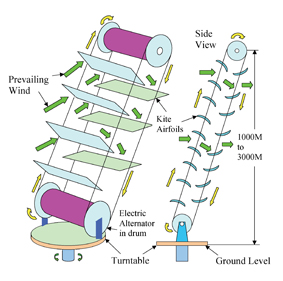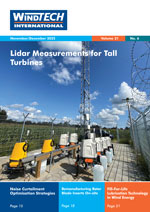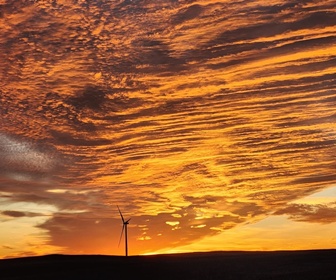Generating Electric Power from High Elevation Winds in Valleys
 Powerful winds blow through mountain valleys worldwide. Some of these winds originate over a large body of water, such as an ocean or a sea, and accelerate to high velocity due to the low friction of the boundary layer that exists between air and water. Many such winds blow towards coastal mountains, for example the Atlas Mountains of Northwestern Africa. Powerful winds also blow at high altitudes towards valleys in mountain ranges such as the Alps. There are many valleys at various elevations in these mountains into which coastal winds and high-altitude winds may blow and accelerate to higher velocity. It is possible to adapt existing and proven technology, such as cable suspension systems, conveyor technology and airfoils, in order to generate electrical power at higher elevations than can be achieved by wind turbines on towers.
Powerful winds blow through mountain valleys worldwide. Some of these winds originate over a large body of water, such as an ocean or a sea, and accelerate to high velocity due to the low friction of the boundary layer that exists between air and water. Many such winds blow towards coastal mountains, for example the Atlas Mountains of Northwestern Africa. Powerful winds also blow at high altitudes towards valleys in mountain ranges such as the Alps. There are many valleys at various elevations in these mountains into which coastal winds and high-altitude winds may blow and accelerate to higher velocity. It is possible to adapt existing and proven technology, such as cable suspension systems, conveyor technology and airfoils, in order to generate electrical power at higher elevations than can be achieved by wind turbines on towers.
By Harry Valentine, Technical Journalist, Canada .
 Powerful winds blow through mountain valleys worldwide. Some of these winds originate over a large body of water, such as an ocean or a sea, and accelerate to high velocity due to the low friction of the boundary layer that exists between air and water. Many such winds blow towards coastal mountains, for example the Atlas Mountains of Northwestern Africa. Powerful winds also blow at high altitudes towards valleys in mountain ranges such as the Alps. There are many valleys at various elevations in these mountains into which coastal winds and high-altitude winds may blow and accelerate to higher velocity. It is possible to adapt existing and proven technology, such as cable suspension systems, conveyor technology and airfoils, in order to generate electrical power at higher elevations than can be achieved by wind turbines on towers.
Powerful winds blow through mountain valleys worldwide. Some of these winds originate over a large body of water, such as an ocean or a sea, and accelerate to high velocity due to the low friction of the boundary layer that exists between air and water. Many such winds blow towards coastal mountains, for example the Atlas Mountains of Northwestern Africa. Powerful winds also blow at high altitudes towards valleys in mountain ranges such as the Alps. There are many valleys at various elevations in these mountains into which coastal winds and high-altitude winds may blow and accelerate to higher velocity. It is possible to adapt existing and proven technology, such as cable suspension systems, conveyor technology and airfoils, in order to generate electrical power at higher elevations than can be achieved by wind turbines on towers.By Harry Valentine, Technical Journalist, Canada .










